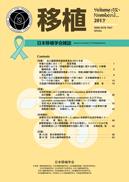Volume 50, Issue 2-3
Displaying 1-22 of 22 articles from this issue
- |<
- <
- 1
- >
- >|
-
2015Volume 50Issue 2-3 Pages 100-105
Published: July 31, 2015
Released on J-STAGE: August 07, 2015
Download PDF (5636K) -
2015Volume 50Issue 2-3 Pages 106-111
Published: July 31, 2015
Released on J-STAGE: August 07, 2015
Download PDF (5255K) -
2015Volume 50Issue 2-3 Pages 112-117
Published: July 31, 2015
Released on J-STAGE: August 07, 2015
Download PDF (890K) -
2015Volume 50Issue 2-3 Pages 118-124
Published: July 31, 2015
Released on J-STAGE: August 07, 2015
Download PDF (408K) -
2015Volume 50Issue 2-3 Pages 125-129
Published: July 31, 2015
Released on J-STAGE: August 07, 2015
Download PDF (1883K)
-
2015Volume 50Issue 2-3 Pages 130-131
Published: July 31, 2015
Released on J-STAGE: August 07, 2015
Download PDF (103K) -
2015Volume 50Issue 2-3 Pages 132-137
Published: July 31, 2015
Released on J-STAGE: August 07, 2015
Download PDF (255K) -
2015Volume 50Issue 2-3 Pages 138-155
Published: July 31, 2015
Released on J-STAGE: August 07, 2015
Download PDF (647K) -
2015Volume 50Issue 2-3 Pages 156-169
Published: July 31, 2015
Released on J-STAGE: August 07, 2015
Download PDF (1182K) -
2015Volume 50Issue 2-3 Pages 170-174
Published: July 31, 2015
Released on J-STAGE: August 07, 2015
Download PDF (579K) -
2015Volume 50Issue 2-3 Pages 175-178
Published: July 31, 2015
Released on J-STAGE: August 07, 2015
Download PDF (1260K) -
2015Volume 50Issue 2-3 Pages 179-185
Published: July 31, 2015
Released on J-STAGE: August 07, 2015
Download PDF (1804K) -
2015Volume 50Issue 2-3 Pages 186-190
Published: July 31, 2015
Released on J-STAGE: August 07, 2015
Download PDF (720K) -
2015Volume 50Issue 2-3 Pages 191-195
Published: July 31, 2015
Released on J-STAGE: August 07, 2015
Download PDF (833K) -
2015Volume 50Issue 2-3 Pages 196-202
Published: July 31, 2015
Released on J-STAGE: August 07, 2015
Download PDF (3963K)
Original Article
-
2015Volume 50Issue 2-3 Pages 203-210
Published: July 31, 2015
Released on J-STAGE: August 07, 2015
Download PDF (372K) -
2015Volume 50Issue 2-3 Pages 211-215
Published: July 31, 2015
Released on J-STAGE: August 07, 2015
Download PDF (288K) -
2015Volume 50Issue 2-3 Pages 216-228
Published: July 31, 2015
Released on J-STAGE: August 07, 2015
Download PDF (4304K)
Case Report
-
2015Volume 50Issue 2-3 Pages 229-233
Published: July 31, 2015
Released on J-STAGE: August 07, 2015
Download PDF (9733K)
-
2015Volume 50Issue 2-3 Pages 234-317
Published: July 31, 2015
Released on J-STAGE: August 07, 2015
Download PDF (2404K) -
2015Volume 50Issue 2-3 Pages 318-323
Published: July 31, 2015
Released on J-STAGE: August 07, 2015
Download PDF (431K) -
2015Volume 50Issue 2-3 Pages 324-336
Published: July 31, 2015
Released on J-STAGE: August 07, 2015
Download PDF (707K)
- |<
- <
- 1
- >
- >|
